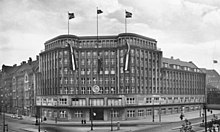Reich youth leadership


The Reich Youth Leadership was after the takeover of the Nazi Party founded in March 1933, the ideological to guarantee orientation of German youth and secure as the future rule of the Nazi Party. The Reichsjugendführer was at the head of the Hitler Youth (HJ, including Jungvolk and BDM ) and was in personal union “Youth Leader of the German Reich ” and Reich Youth Leader of the NSDAP.
Baldur von Schirach was the first Reich youth leader. He was replaced on August 8, 1940 by his deputy Artur Axmann .
tasks
The tasks of the Reich Youth Leadership were to bring the existing youth associations into line, the political and ideological indoctrination of German youth with the aim of educating them to become convinced National Socialists and the control and suppression of youth cultures that deviated from the Nazi ideal.
After taking power, the Nazi regime did not tolerate any other youth associations besides the Hitler Youth. The other groups were disbanded if they did not join voluntarily. One of the largest of these groups was the “ Bündische Jugend ” - a collective term that emerged in the 1920s for youth associations influenced by the youth movement . Most of the young people came from the middle class. What the groups had in common was the idea of self-determination (“youth educates youth”), as well as joint activities such as hiking and camping , making music and singing . A strong connection to home and nature showed in particular the two dominant directions, the Wandervogel movement and the boy scouts . The German Freischar formed in 1927 from some of these unions , which merged with other youth organizations to form the Greater German Confederation in early 1933 and hoped to avoid dissolution. Parts of the federal government cooperated with the Hitler Youth, which hoped it would strengthen it, but then wanted to get rid of the competition.
The Reichsjugendführung accommodated the Hitler Youth's claims to power and forbade the Greater German League as early as June 1933. The remaining groups of the “Bündische Jugend” suffered this fate in the years up to 1936. Many of their members switched to the Hitler Youth, especially when they became mandatory "State youth" became and could exert even more pressure. The Hitler Youth adopted some of the Bundish forms and methods, including uniforms and the tent camps. Only the Catholic youth and the Protestant youth were able to maintain a small degree of freedom of movement.
In order to justify the suppression of the Bundestag youth, they were accused of cooperating with communists. The RJF functionary Gerhard Mögling described them as “the bearer of Bolshevism ” and “the sharpest opponent of the HJ”. Even when the latter had stabilized and gained members, the Reich Youth Leadership retained this constructed assertion “alliance = communist” and pursued all those who withdrew from integration into the final phase of the Third Reich .
Dual position as party structure and Reich authority
Legally, the youth leader of the German Reich was a supreme Reich authority (roughly equivalent to a ministry) with its seat in Berlin . and at the same time was part of the party apparatus of the NSDAP. It was structured according to the leader principle . From 1933 to 1940 Baldur von Schirach , who had been Reich Youth Leader of the NSDAP since 1931, was at its head . From 1940 to 1945 he was followed by his long-time deputy and Hitler Youth leader, Artur Axmann .
Within the party, the Reich Youth Leader was responsible for the guidelines according to which the children and young people registered in the Hitler Youth and in the Bund Deutscher Mädel were cared for and brought up. The HJ, which was initially a youth organization of the party, received the status of a state youth in 1936. Even before that, the Reich Youth Leadership began to develop the Hitler Youth through strict obedience education , extreme discipline and aggressive physical activity as a counterbalance to school education.
In addition to this guideline competence , the Reich Youth Leadership was also a direct power factor because it perceived the police- like design of HJ operations. The Hitler Youth patrol service was particularly feared .
Use after 1945
The Deutsche Reichsjugend , the youth organization of the right-wing extremist Socialist Reich Party , which was banned in 1952, continued to use the term Reichsjugendführer for the office of federal chairman. Walter Matthaei , the first and only "Reichsjugendführer", used the term consciously in the tradition of National Socialism. He founded the Wiking Youth in 1952.
See also
- Office building at Heerstraße 12–16 , headquarters of the Reich leadership of the Reich Youth Leadership at what was then Kaiserdamm 45/46 in Berlin
- Otto Abetz , " France -referent" of the Reich Youth Leadership, comes from the Bündische Jugend
